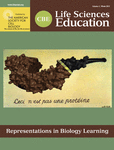Abstract
This study examined the historical performance of students at Michigan State University in 12 life sciences courses over 13 yr to find variables impacting student success. Hierarchical linear modeling predicted 25.0–62.8% of the variance in students’ grades in the courses analyzed. The primary predictor of a student's course grade was his or her entering grade point average; except for the second course in a series (i.e., Biochemistry II), in which the grade for the first course in the series (i.e., Biochemistry I) was often the best predictor, as judged by β values. Student gender and major were also statistically significant for a majority of the courses studied. Female students averaged grades 0.067–0.303 lower than their equivalent male counterparts, and majors averaged grades were 0.088–0.397 higher than nonmajors. Grades earned in prerequisite courses provided minimal predictive ability. Ethnicity and involvements in honors college or science residential college were generally insignificant.



